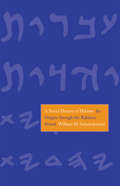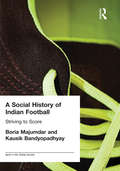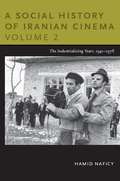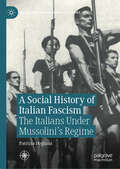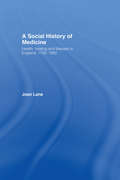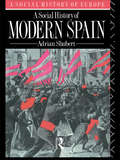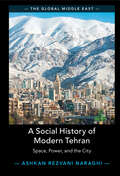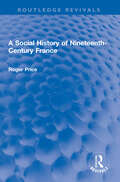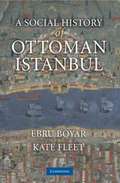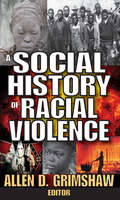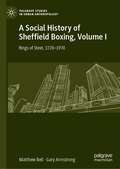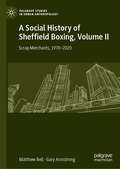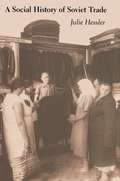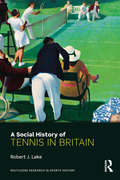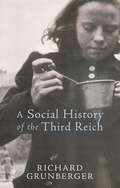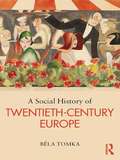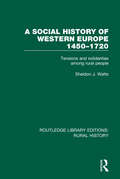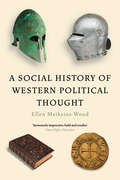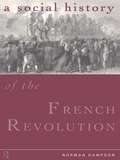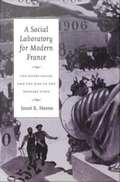- Table View
- List View
A Social History of Hebrew
by William M. SchniedewindMore than simply a method of communication shared by a common people, the Hebrew language was always an integral part of the Jewish cultural system and, as such, tightly interwoven into the lives of the prophets, poets, scribes, and priests who used it. In this unique social history, William Schniedewind examines classical Hebrew from its origins in the second millennium BCE until the Rabbinic period, when the principles of Judaism as we know it today were formulated, to view the story of the Israelites through the lens of their language. Considering classical Hebrew from the standpoint of a writing system as opposed to vernacular speech, Schniedewind demonstrates how the Israelites' long history of migration, war, exile, and other momentous events is reflected in Hebrew's linguistic evolution. An excellent addition to the fields of biblical and Middle Eastern studies, this fascinating work brings linguistics and social history together for the first time to explore an ancient culture.
A Social History of Indian Football: Striving to Score (Sport in the Global Society)
by Boria Majumdar Kausik BandyopadhyayA Social History of Indian Football covers the period 1850-2004. It considers soccer as a derivative sport, creatively and imaginatively adapted to suit modern Indian socio-cultural needs - designed to fulfil political imperatives and satisfy economic aspirations. The book is concerned with the appropriation, assimilation and subversion of sporting ideals in colonial and post-colonial India for nationalist needs. The book assesses the role of soccer in colonial Indian life, to delineate the inter-relationship between those who patronised, promoted, played and viewed the game, to analyse the impact of the colonial context on the games evolution and development and shed light on the diverse nature of trysts with the sport across the country. Throughout this book, soccer is the lens that illuminates India's colonial and post-colonial encounter.This volume was previously published as a special issue of the journal Soccer and Society.
A Social History of Iranian Cinema: The Industrializing Years, 1941-1978
by Hamid NaficyHamid Naficy is one of the world's leading authorities on Iranian film, and A Social History of Iranian Cinema is his magnum opus. Covering the late nineteenth century to the early twenty-first and addressing documentaries, popular genres, and art films, it explains Iran's peculiar cinematic production modes, as well as the role of cinema and media in shaping modernity and a modern national identity in Iran. This comprehensive social history unfolds across four volumes, each of which can be appreciated on its own. Volume 2 spans the period of Mohammad Reza Shah's rule, from 1941 until 1978. During this time Iranian cinema flourished and became industrialized, at its height producing more than ninety films each year. The state was instrumental in building the infrastructures of the cinema and television industries, and it instituted a vast apparatus of censorship and patronage. During the Second World War the Allied powers competed to control the movies shown in Iran. In the following decades, two distinct indigenous cinemas emerged. The more popular, traditional, and commercial filmfarsi movies included tough-guy films and the "stewpot" genre of melodrama, with plots reflecting the rapid changes in Iranian society. The new-wave cinema was a smaller but more influential cinema of dissent, made mostly by foreign-trained filmmakers and modernist writers opposed to the regime. Ironically, the state both funded and censored much of the new-wave cinema, which grew bolder in its criticism as state authoritarianism consolidated. A vital documentary cinema also developed in the prerevolutionary era. A Social History of Iranian CinemaVolume 1: The Artisanal Era, 1897-1941 Volume 2: The Industrializing Years, 1941-1978 Volume 3: The Islamicate Period, 1978-1984 Volume 4: The Globalizing Era, 1984-2010
A Social History of Italian Fascism: The Italians Under Mussolini’s Regime (Italian and Italian American Studies)
by Patrizia DoglianiThis book uncovers how fascism reshaped Italian society according to its ideological and historical interpretation of the Italian nation and people and identifies the strengths of this transformation, but also the resistance encountered from, for example, women and minority groups, to accept it in everyday life. It analyzes the success achieved by some policies aimed at popular masses in order to integrate them into the nation, and how fascism initiated an early welfare state project to address specific categories of society such as veterans, families, mothers and children. The book also questions the concept and practices of social citizenship reserved only for those who gave evidence of formal adherence to fascism.
A Social History of Maoist China: Conflict and Change, 1949–1976 (New Approaches to Asian History)
by Felix WemheuerWhen the Chinese communists came to power in 1949, they promised to 'turn society upside down'. Efforts to build a communist society created hopes and dreams, coupled with fear and disillusionment. The Chinese people made great efforts towards modernization and social change in this period of transition, but they also experienced traumatic setbacks. Covering the period 1949 to 1976 and then tracing the legacy of the Mao era through the 1980s, Felix Wemheuer focuses on questions of class, gender, ethnicity, and the urban-rural divide in this new social history of Maoist China. He analyzes the experiences of a range of social groups under Communist rule - workers, peasants, local cadres, intellectuals, 'ethnic minorities', the old elites, men and women. To understand this tumultuous period, he argues, we must recognize the many complex challenges facing the People's Republic. But we must not lose sight of the human suffering and political terror that, for many now ageing quietly across China, remain the period's abiding memory.
A Social History of Medicine: Health, Healing and Disease in England, 1750-1950
by Joan LaneA Social History of Medicine traces the development of medical practice from the Industrial Revolution right through to the twentieth century. Drawing on a wide range of source material, it charts the changing relationship between patients and practitioners over this period, exploring the impact made by institutional care, government intervention and scientific discovery. The study illuminates the extent to which medical assistance really was available to patients over the period, by focusing on provincial areas and using local sources. It introduces a variety of contemporary medical practitioners, some of them hitherto unknown and with fascinating intricate details of their work. The text offers an extensive thematic survey, including coverage of: * institutions such as hospitals, dispensaries, asylums and prisons* midwifery and nursing* infections and how changes in science have affected disease control* contraception, war, and the NHS.
A Social History of Medicines in the Twentieth Century: To Be Taken Three Times a Day
by John Crellin Dennis B WorthenGet a fresh perspective on the day-to-day use of medicine! A Social History of Medicines in the Twentieth Century explores the most perplexing issues concerning the uses of prescriptions and other medicines on both sides of the Atlantic. The book equips you with a thorough understanding of the everyday use of medicine in the United States, Canada, and Britain, concentrating on its recent past. Dr. John K. Crellin, author of several influential books on the history of medicine and pharmacy, addresses vital topics such as: the emergence of prescription-only medicines; gate-keeping roles for pharmacists; the role of the drugstore; and the rise of alternative medicines. A Social History of Medicines in the Twentieth Century adds the historical perspective missing from most medical and pharmaceutical literature about trends in the day-to-day use of medicines in society. The book is essential reading for anyone taking regular medication, either as self-care or by a physician&’s prescription. Topics discussed include the non-scientific factors that validate medicines, the relevance of the control of narcotics, marketing strategies used by the pharmaceutical industry, the changing authority of physicians and pharmacists, over-the-counter medicines, tonics and sedatives, and patient compliance-and non-compliance. A Social History of Medicines in the Twentieth Century also addresses: medicines for weakness ("health" foods, fortifiers, digestives/laxatives) poison and pharmacy legislation placebos tranquilizers and antidepressants hormones side-effects psychoactive medications herbal medicines a brief history of the use of medicines from the 17th to 19th centuries suggestions for future policies and much more! A Social History of Medicines in the Twentieth Century is equally vital as a professional resource for physicians, pharmacists, and health care administrators, as a classroom guide for academics working in the medical and pharmaceutical fields, and as a resource for patients.
A Social History of Modern Spain (Social History Of Europe Ser.)
by Adrian ShubertInsightful and accessible, A Social History of Modern Spain is the first comprehensive social history of modern Spain in any language. Adrian Shubert analyzes the social development of Spain since 1800. He explores the social conflicts at the root of the Spanish Civil War and how that war and the subsequent changes from democracy to Franco and back again have shaped the social relations of the country. Paying equal attention to the rural and urban worlds and respecting the great regional diversity within Spain, Shubert draws a sophisticated picture of a country struggling with the problems posed by political, economic, and social change. He begins with an overview of the rural economy and the relationship of the people to the land, then moves on to an analysis of the work and social lives of the urban population. He then discusses the changing roles of the clergy, the military, and the various local government, community, and law enforcement officials. A Social History of Modern Spain concludes with an analysis of the dramatic political, economic, and social changes during the Franco regime and during the subsequent return to democracy.
A Social History of Modern Tehran: Space, Power, and the City (The Global Middle East #22)
by Ashkan Rezvani NaraghiTehran, the capital of Iran since the late eighteenth century, is now one of the largest cities in the Middle East. Exploring Tehran's development from the nineteenth to the mid-twentieth century, Ashkan Rezvani Naraghi paints a vibrant picture of a city undergoing rapid and dynamic social transformation. Rezvani Naraghi demonstrates that this shift was the product of a developing discourse around spatial knowledge, in which the West became the model for the social practices of the state and sections of Iranian society. As traditional social spaces, such as coffee houses, bathhouses, and mosques, were replaced by European-style cafes, theatres, and sports clubs, Tehran and its people were irreversibly altered. Using an array of archival sources, Rezvani Naraghi stresses the agency of everyday inhabitants in shaping urban change. This enlightening history not only allows us to better understand the contours of contemporary Tehran, but to develop a new way of imagining, talking about, and building 'the city'.
A Social History of Nineteenth-Century France (Routledge Revivals)
by Roger PriceFirst published in 1987, A Social History of Nineteenth-Century France argues that the social impact of the French Revolution has been greatly exaggerated, and that in 1815 France was still predominantly a rural and pre-industrial society. The revolution introduced only very limited changes in social structures and relationships – the daily lives of ordinary people remained virtually unchanged. A much more decisive turning point in French history, the author suggests, was the period of structural change in economy and society, which began in the mid nineteenth century. The first part of the book looks at many changes in the economy and their effect on living standards and social environment. The second part identifies the social groups which make up French society and provides detailed analyses of their lifestyles and social relationships. Part Three considers the influence of such key institutions as churches, schools, and the state. Drawing on an exceptionally wide range of primary sources, this is likely to be the definitive overview of French society for many years to come and will be of interest to researchers of French history and European history.
A Social History of Ottoman Istanbul
by Ebru Boyar Kate FleetUsing a wealth of contemporary Ottoman sources, this book recreates the social history of Istanbul, a huge, cosmopolitan metropolis and imperial capital of the Ottoman Empire. Seat of the Sultan and an opulent international emporium, Istanbul was also a city of violence shaken regularly by natural disasters and by the turmoil of sultanic politics and violent revolt. Its inhabitants, entertained by imperial festivities and cared for by the great pious foundations which touched every aspect of their lives, also amused themselves in the numerous pleasure gardens and the many public baths of the city. While the book is focused on Istanbul, it presents a broad picture of Ottoman society, how it was structured and how it developed and transformed across four centuries. As such, the book offers an exciting alternative to the more traditional histories of the Ottoman Empire.
A Social History of Racial Violence
by Allen D. GrimshawNo topic has been discussed at greater length or with more vigor than the racial confrontations of the 1960s. Events of these years left behind hundreds dead; thousands injured and arrested, property damage beyond toll, and a population both outraged and conscience stricken. Researchers have offered a variety of explanations for this largely urban violence. Although many Americans reacted as if the violence was a new phenomenon, it was not. Racial Violence in the United States places the events of the 1960s into historical perspective. The book includes accounts of racial violence from different periods in American history, showing these disturbing events in their historical context and providing suggestive analyses of their social, psychological, and political causes and implications.Grimshaw includes reports and studies of racial violence from the slave insurrections of the seventeenth century to urban disturbances of the 1960s. The result is more than a descriptive record. Its contents not only demonstrate the historical nature of the problem but also provide a review of major theoretical points of view. The volume defines patterns in past and present disturbances, isolates empirical generalizations, and samples the substantial body of literature that has attempted to explain this ultimate form ofsocial conflict. It includes selections on the characteristics of rioters, on the ecology of riots, and on the role of law in urban violence, as well as theoretical interpretations developed by psychologists, sociologists, political scientists, and other observers. The resulting volume will help interested readers better understand the violence that accompanied the attempts of black Americans to gain for themselves full equality.
A Social History of Sheffield Boxing, Volume I: Rings of Steel, 1720–1970 (Palgrave Studies in Urban Anthropology)
by Gary Armstrong Matthew BellA Social History of Sheffield Boxing combines urban ethnography and anthropology, sociological theory and place and life histories to explore the global phenomenon of boxing. Raising many issues pertinent to the social sciences, such as contestations around state regulation of violence, commerce and broadcasting, pedagogy and elite sport and how sport is delivered and narrated to the masses, the book studies the history of boxing in Sheffield and the sport’s impact on the cultural, political and economic development of the city since the 18th century. Interweaving urban anthropology with sports studies and historical research the text expertly examines a variety of published sources, ranging from academic papers to biographies and from newspaper reports to case studies and contemporary interviews. In Volume I, Bell and Armstrong construct a vivid history of boxing and probe its cultural acceptance in the late 1800s, examining how its rise was inextricably intertwined with the industrial and social development of Sheffield. Although Sheffield was not a national player in prize-fighting’s early days, throughout the mid-1800s, many parochial scores and wagers were settled by the use of fists. By the end of the century, boxing with gloves had become the norm, and Sheffield had a valid claim to be the chief provincial focus of this new passion—largely due to the exploits of George Corfield, Sheffield’s first boxer of national repute. Corfield’s deeds were later surpassed by three British champions: Gus Platts, Johnny Cuthbert and Henry Hall. Concluding with the dual themes of the decline of boxing in Sheffield and the city's changing social profile from the 1950s onwards, the volume ends with a meditation on the arrival of new migrants to the city and the processes that aided or frustrated their integration into UK life and sport.
A Social History of Sheffield Boxing, Volume II: Scrap Merchants, 1970-2020 (Palgrave Studies in Urban Anthropology)
by Gary Armstrong Matthew BellA Social History of Sheffield Boxing combines urban ethnography and anthropology, sociological theory and place and life histories to explore the global phenomenon of boxing. Raising many issues pertinent to the social sciences, such as contestations around state regulation of violence, commerce and broadcasting, pedagogy and elite sport and how sport is delivered and narrated to the masses, the book studies the history of boxing in Sheffield and the sport’s impact on the cultural, political and economic development of the city since the 18th century. Interweaving urban anthropology with sports studies and historical research the text expertly examines a variety of published sources, ranging from academic papers to biographies and from newspaper reports to case studies and contemporary interviews. In Volume II, Bell and Armstrong examine the revival of Sheffield boxing after the decline of the 1950s and 1960s outlined in Volume I. Instigated by two men from outside the city—Brendan Ingle and Herol Graham—this renaissance became known as the ‘Ingle style,’ which between 1995 and 2014 produced four world champions: Naseem Hamed, Johnny Nelson, Junior Witter and Kell Brook. These successes inspired others and raised Sheffield’s profile as a boxing city, which in the 1990s and 2000s produced two more world champions in Paul ‘Silky’ Jones and Clinton Woods. In this second volume, Bell and Armstrong track the resurgence of boxing to the present day and consider how the game and its players have changed over time.
A Social History of Soviet Trade: Trade Policy, Retail Practices, and Consumption, 1917-1953
by Julie HesslerIn this sweeping study, Julie Hessler traces the invention and evolution of socialist trade, the progressive constriction of private trade, and the development of consumer habits from the 1917 revolution to Stalin's death in 1953. The book places trade and consumption in the context of debilitating economic crises. Although Soviet leaders, and above all, Stalin, identified socialism with the modernization of retailing and the elimination of most private transactions, these goals conflicted with the economic dynamics that produced shortages and with the government's bureaucratic, repressive, and socially discriminatory political culture.A Social History of Soviet Trade explores the relationship of trade--official and unofficial--to the cyclical pattern of crisis and normalization that resulted from these tensions. It also provides a singularly detailed look at private shops during the years of the New Economic Policy, and at the remnants of private trade, mostly concentrated at the outdoor bazaars, in subsequent years. Drawing on newly opened archives in Moscow and several provinces, this richly documented work offers a new perspective on the social, economic, and political history of the formative decades of the USSR.
A Social History of Tennis in Britain (Routledge Research in Sports History)
by Robert J. LakeWinner of the Lord Aberdare Literary Prize 2015- from the British Society for Sports History. From its advent in the mid-late nineteenth century as a garden-party pastime to its development into a highly commercialised and professionalised high-performance sport, the history of tennis in Britain reflects important themes in Britain’s social history. In the first comprehensive and critical account of the history of tennis in Britain, Robert Lake explains how the game’s historical roots have shaped its contemporary structure, and how the history of tennis can tell us much about the history of wider British society. Since its emergence as a spare-time diversion for landed elites, the dominant culture in British tennis has been one of amateurism and exclusion, with tennis sitting alongside cricket and golf as a vehicle for the reproduction of middle-class values throughout wider British society in the twentieth and twenty-first centuries. Consequently, the Lawn Tennis Association has been accused of a failure to promote inclusion or widen participation, despite steadfast efforts to develop talent and improve coaching practices and structures. Robert Lake examines these themes in the context of the global development of tennis and important processes of commercialisation and professional and social development that have shaped both tennis and wider society. The social history of tennis in Britain is a microcosm of late-nineteenth and twentieth-century British social history: sustained class power and class conflict; struggles for female emancipation and racial integration; the decline of empire; and, Britain’s shifting relationship with America, continental Europe, and Commonwealth nations. This book is important and fascinating reading for anybody with an interest in the history of sport or British social history.
A Social History of The Third Reich
by Richard GrunbergerOne of the most devastating portraits ever drawn of a human society - life in Hitler's Germany during the Third ReichThe Nazis developed a social system unprecedented in history. It was rigidly hierarchical, with the seemingly beneficent and ascetic figure of Hitler at the top - focus for the homage and aspirations of every man,woman and child. How did the 'ordinary citizen' live under such a system? The author discusses such subjects as beauty in the Third Reich (no cosmetics, no slimming) as well as charting how you progressed to the elite Nazi cadres - administrators, propagandists or coercers. It shows childhood with the Hitler Youth and describes the intense medieval ritual injected into every phase of life from school and university to farm labour. It shows life in the office, in industry, in the professions - doctors, lawyers, artists - and in the Nazi Party itself. Finally, it documents what happened at the two extremes of German society - to the aristocrats and to the Jews.
A Social History of Truth: Civility and Science in Seventeenth-Century England (Science and Its Conceptual Foundations series)
by Steven ShapinHow do we come to trust our knowledge of the world? What are the means by which we distinguish true from false accounts? Why do we credit one observational statement over another? In A Social History of Truth, Shapin engages these universal questions through an elegant recreation of a crucial period in the history of early modern science: the social world of gentlemen-philosophers in seventeenth-century England. Steven Shapin paints a vivid picture of the relations between gentlemanly culture and scientific practice. He argues that problems of credibility in science were practically solved through the codes and conventions of genteel conduct: trust, civility, honor, and integrity. These codes formed, and arguably still form, an important basis for securing reliable knowledge about the natural world. Shapin uses detailed historical narrative to argue about the establishment of factual knowledge both in science and in everyday practice. Accounts of the mores and manners of gentlemen-philosophers are used to illustrate Shapin's broad claim that trust is imperative for constituting every kind of knowledge. Knowledge-making is always a collective enterprise: people have to know whom to trust in order to know something about the natural world.
A Social History of Twentieth-Century Europe
by Béla TomkaA Social History of Twentieth-Century Europe offers a systematic overview on major aspects of social life, including population, family and households, social inequalities and mobility, the welfare state, work, consumption and leisure, social cleavages in politics, urbanization as well as education, religion and culture. It also addresses major debates and diverging interpretations of historical and social research regarding the history of European societies in the past one hundred years. Organized in ten thematic chapters, this book takes an interdisciplinary approach, making use of the methods and results of not only history, but also sociology, demography, economics and political science. Béla Tomka presents both the diversity and the commonalities of European societies looking not just to Western European countries, but Eastern, Central and Southern European countries as well. A perfect introduction for all students of European history.
A Social History of Western Europe, 1450-1720: Tensions and Solidarities among Rural People (Routledge Library Editions: Rural History #15)
by Sheldon J. WattsThis thoroughly readable and stimulating social history of Western Europe, first published in 1984, explores the family, religion and the supernatural, and the social structure and social controls of rural society. This title will be of interest not only to students, but to anyone who is anxious to understand the lives – both internal and external – of rural people in his fascinating period that is so central to everyone’s past.
A Social History of Western Political Thought
by Ellen Meiksins WoodA sweeping and nuanced materialist history of Western political thoughtIn this groundbreaking work, Ellen Meiksins Wood rewrites the history of political theory, from Plato to Rousseau. Treating canonical thinkers as passionately engaged human beings, Wood examines their ideas not simply in the context of political languages but as creative responses to the social relations and conflicts of their time and place. She identifies a distinctive relation between property and state in Western history and shows how the canon, while largely the work of members or clients of dominant classes, was shaped by complex interactions among proprietors, labourers and states. Western political theory, Wood argues, owes much of its vigour, and also many ambiguities, to these complex and often contradictory relations. In the first volume, she traces the development of the Western tradition from classical antiquity through to the Middle Ages in the perspective of social history—a significant departure not only from the standard abstract history of ideas but also from other contextual methods. From the Ancient Greek polis of Plato, Aristotle, Aeschylus and Sophocles, through the Roman Republic of Cicero and the Empire of St Paul and St Augustine, to the medieval world of Averroes, Thomas Aquinas and William of Ockham, Wood offers a rich, dynamic exploration of thinkers and ideas that have indelibly stamped our modern world. In the second volume, Wood addresses the formation of the modern state, the rise of capitalism, the Renaissance and Reformation, the scientific revolution and the Age of Enlightenment, which have all been attributed to the &“early modern&” period. Nearly everything about its history remains controversial, but one thing is certain: it left a rich and provocative legacy of political ideas unmatched in Western history. The concepts of liberty, equality, property, human rights and revolution born in those turbulent centuries continue to shape, and to limit, political discourse today. Assessing the work and background of figures such as Machiavelli, Luther, Calvin, Spinoza, the Levellers, Hobbes, Locke and Rousseau, Ellen Wood vividly explores the ideas of the canonical thinkers, not as philosophical abstractions but as passionately engaged responses to the social conflicts of their day.
A Social History of the English Countryside
by G. E. MingayTraces the rise and fall of rural England from the Middle Ages to the Second World War and the nature of the changes which have occurred.
A Social History of the French Revolution (Study In Social History Ser.)
by Norman HampsonThe revolutionary movement which began in 1787 disrupted every aspect of French society, rising to a pitch of such extreme violence that the effects are still felt in France today. The Revolution was the product of social tensions that developed throughout France in the second half of the eighteenth century. Norman Hampson analyses the nature of these social conflicts within their political framework. With enough background information to satisfy the general reader with no previous knowledge of the subject, Norman Ha mpson's book devotes particular attention to provincial France. The result is both a picture of the supreme crisis in French society, and an examination of social attitudes and aspirations whose influence has been universal and enduring.
A Social Laboratory for Modern France: The Musée Social & the Rise of the Welfare State
by Janet R. HorneAs a nineteenth-century think tank that sought answers to France's pressing "social question," the Musée Social reached across political lines to forge a reformist alliance founded on an optimistic faith in social science. In A Social Laboratory for Modern France Janet R. Horne presents the story of this institution, offering a nuanced explanation of how, despite centuries of deep ideological division, the French came to agree on the basic premises of their welfare state. Horne explains how Musée founders believed--and convinced others to believe--that the Third Republic would carry out the social mission of the French Revolution and create a new social contract for modern France, one based on the rights of citizenship and that assumed collective responsibility for the victims of social change. Challenging the persistent notion of the Third Republic as the stagnant backwater of European social reform, Horne instead depicts the intellectually sophisticated and progressive political culture of a generation that laid the groundwork for the rise of a hybrid welfare system, characterized by a partnership between private agencies and government. With a focus on the cultural origins of turn-of-the-century thought--including religion, republicanism, liberalism, solidarism, and early sociology--A Social Laboratory for Modern France demonstrates how French reformers grappled with social problems that are still of the utmost relevance today and how they initiated a process that gave the welfare state the task of achieving social cohesion within an industrializing republic.
A Social Psychology Perspective on The Israeli-Palestinian Conflict: Celebrating the Legacy of Daniel Bar-Tal, Vol II. (Peace Psychology Book Series)
by Eran Halperin Keren SharvitDue to its intensity and extensive effects both locally and globally, the Israeli-Palestinian conflict has drawn the attention of scholars from numerous disciplines, who attempt to explain the causes of the conflict and the reasons for the difficulties in resolving it. Among these one can find historians, geographers, political scientists, sociologists and others. This volume explores the Israeli-Palestinian conflict from a social psychology perspective. At the core of the book is a theory of intractable conflicts, as developed by Daniel Bar-Tal of Tel Aviv University, applied to the Israeli-Palestinian conflict. Opening with an introduction to the Israeli-Palestinian conflict situation and a few chapters on the theoretical backgrounds of the creation of a societal ethos of conflict, the volume then moves to an analysis of the psycho-social underpinnings of the conflict, while concluding with a discussion of the possibility of long-standing peace in the region. Among the topics included in the coverage are: · Identity formation during conflict · The Israeli and Palestinian ethos of conflict · The important role of Palestinian and Israeli education · An analysis of the leadership in the Israeli-Palestinian peace process · The challenges and potential towards a road to peace in the region All contributors to the volume are pre-eminent scholars of the Israeli-Palestinian conflict, and many of them have felt the influence of Bar-Tal's formulations in their own work. A rich resource for those who are followers of Dr. Bar-Tal's work, for those who study intractable conflicts in all its forms, and for those who have a particular interest in the Israeli-Palestinian conflict, A Social Psychology Perspective of the Israeli-Palestinian Case offers a detailed exploration of the psychological underpinnings of the Israeli-Palestinian conflict and the barriers to and opportunities of the peace process.
